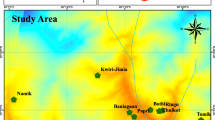Abstract
The article describes the food insecurity situation in three villages in northern Ghana. A livelihood approach is used emphasising the vulnerability of the peasants’ adaptation to a marginal and remote area. The peasant households are grouped according to level of food insecurity. It is argued that multiple income sources including non-farm activities are necessary to reduce food insecurity for all but a small part of the peasant households.
Similar content being viewed by others
References
Abdulai, A., & CroleRees, A. (2001). Determinants of income diversification amongst rural households in Southern Mali. Food Policy, 26, 437–452
Barrett, C. B., Reardon, T., & Webb, P. (2001). Nonfarm income diversification and household livelihood strategies in rural Africa: concepts, dynamics, and policy implications. Food Policy, 26, 315–331
Baumann, P., & Sinha, S. (2001). Linking development with democratic processes in India: Political capital and sustainable livelihoods analysis. Natural Resource Perspectives 68, Overseas Development Institute, London
Bening, R. B. (1976). Land tenure system and traditional agriculture of the Sissala. Bulletin of the Ghana Geographical Association, 18, 15–31
Block, S., & Webb, P. (2001). The dynamics of livelihood diversification in post-famine Ethiopia. Food policy, 26, 333–350
Bryceson, D. F. (1997). De-agrarianisation in Sub-Saharan Africa: Acknowledging the Inevitable. In D. F. Brycesson, & V. Jamal (Eds.), Farewell to farms: De-agrarianisation and employment in Africa. Leiden: Asgate publishing
Canagarajah, S., Newman, C., & Bhattamishra, R. (2001). Non-farm income, gender, and inequality: Evidence from rural Ghana and Uganda. Food policy, 26, 405–420
Chambers, M. I. (1980). The politics of agricultural and rural development in the Upper East Region of Ghana: Implications of technocratic ideology and non-participatory development. Cornell: Cornell University Press
Chambers, R. (1989). Editorial introduction: Vulnerability, coping and policy. IDS Bulletin, 20, 1–8
Chambers, R., & Conway, G. (1992). Sustainable rural livelihoods: Practical concepts for the 21st century. IDS Discussion Paper 269
Davies, S. (1996). Adaptable livelihoods: Coping with food insecurity in the Malian Sahel. Houndmills: Macmillan
De Waal, A. (1989). Famine that kills: Dafur, Sudan1984–1985. Oxford: Clarendon Press
Dercon, S. (2000). Income risk, coping strategies and safety nets. Centre for the Study of African Economies. Oxford: Oxford University
DFID. (2002). Sustainable livelihoods: Building on strengths. http://www.livelihoods.org/info/docs/SL_BoS.pdf, DFID
Dilley, M., & Boudreau, T. E. (2001). Coming to terms with vulnerability: A critique of the food security definition. Food policy, 26, 229–247
Ellis, F. (1998). Household strategies and rural livelihood diversification. Journal of Development Studies, 35(1), 1–38
Ellis, F. (2000). Rural livelihoods and diversity in developing countries. Oxford: Oxford University Press
EPA (1998). Upper East Regional Profile. Bolgatanga, Ghana: Environmental Protection Agency
Fine, B. (1997). Entitlement failure? Development and Change, 28, 617–647
GSS (2000). Census report 2000. Accra: Ghana Statistical services
Hesselberg, J. (1985). The third world in transition: The case of the peasantry in Botswana. Uppsala: Scandinavian Institute of African Studies
Keen, D. (1994). The benefits of famine: A political economy of famine and relief in southwestern Sudan, 1983–1989. Princeton, NJ: Princeton University Press
Lanjouw, J. O., & Lanjouw, P. (2001). The rural non-farm sector: issues and evidence from developing countries. Agricultural Economics, 26, 1–23
Maxwell, S. (2001). The evolution of thinking about food security. In S. Maxwell, & S. Devereux (Eds.), Food security in Sub-Saharan Africa. Sussex: Institute of Development Studies
Meagher, K., & Mustapha, A. R. (1997). Not by farming alone: The role of non-farm incomes in rural Hausaland. In D. F. Brycesson, & V. Jamal (Eds.), Farewell to farms: De-agrarianisation and employment in Africa. Leiden: Asgate publishing
Oshaug, A. (1985). The composite concept of food security. In W. B. Eide, et al. (Eds.), Introducing nutritional considerations into rural development programs with focus on agriculture: a theoretical contribution. Oslo: Institute for Nutrition Research, University of Oslo
Osmani, S. R. (1993). The entitlement approach to famine: An assessment. Working Papers. No. 107 World Institute for Development Economics Research, Helsinki
Pinstrup-Andersen, P., & Pandya-Lorch, R. (1995). Agricultural growth is the key to poverty alleviation in low-income developing countries. Washington, DC: 2020 Vision Brief
Rangasami, A. (1985a). Failure of exchange entitlements. Theory of famine: A response. Part one. Economic and Political Weekly, 20(42), 1747–1751
Rangasami, A. (1985b). Failure of exchange entitlements. Theory of famine: A response. Part two. Economic and Political Weekly, 20(41), 1797–1801
Ribot, J. (1995). The causal structure of vulnerability: It’s application to climate impact analysis. Geojournal, 35(2), 119–122
Scoones, I. (1998). Sustainable rural livelihoods: A framework for analysis. IDS Working Papers 72, Sussex
Sen, A. (1981). Poverty and famines: An essay on entitlement and deprivation. Oxford: Oxford University Press
Sen, A. (1995). Food, economics and entitlements. In J. Drèze, A. Sen, & A. Hussain (Eds.), The political economy of hunger: Selected essays. Wider studies in development economics. Oxford: Clarendon Press
Sijm, J. (1993). Food security and policy interventions in Ghana. Rotterdam: Nederlans instituut voor Algemeen en Bbedrijfseconomisch Onderzoek
Songsore, J. (1992). The ERP/structural adjustment programme: Their likely impacts on the “ distant” rural poor in Northern Ghana. In A. Ernest (Eds.), Planning African growth and development. Some current issues. Accra: ISSER/UNDP
Songsore, J., & Denkabe, A. (1995). Challenging rural poverty in Northern Ghana: The case of the Upper West Region. Trondheim: Centre for Environment and Development, University of Trondheim
Watts, M., & Bohle, H. (1993). Hunger, famine, and the space of vulnerability. Geojournal, 30(2), 117–126
World Bank (1995). Ghana: Poverty past, present, and future. Washington DC
Yaro, A. J. (2002). The poor peasant: One label, different lives. The dynamics of rural livelihood strategies in the Gia-Kajelo community, Northern Ghana. Norwegian Journal of Geography, 56(1), 10–20
Author information
Authors and Affiliations
Corresponding author
Rights and permissions
About this article
Cite this article
Hesselberg, J., Yaro, J.A. An assessment of the extent and causes of food insecurity in northern Ghana using a livelihood vulnerability framework. GeoJournal 67, 41–55 (2006). https://doi.org/10.1007/s10708-006-9007-2
Received:
Accepted:
Published:
Issue Date:
DOI: https://doi.org/10.1007/s10708-006-9007-2




